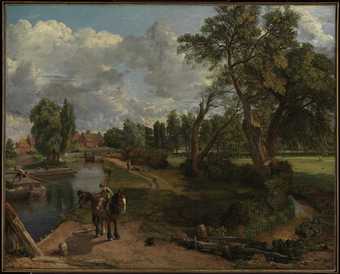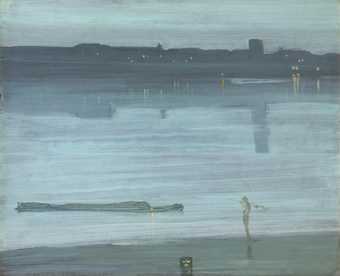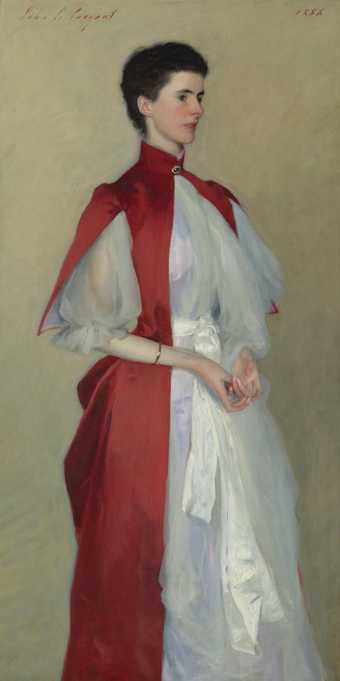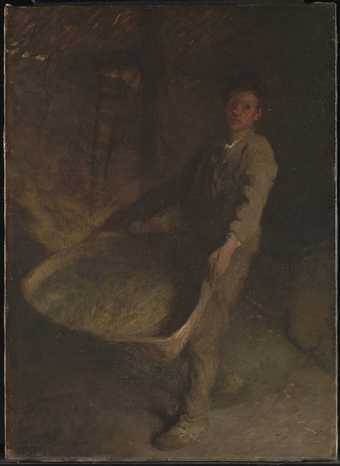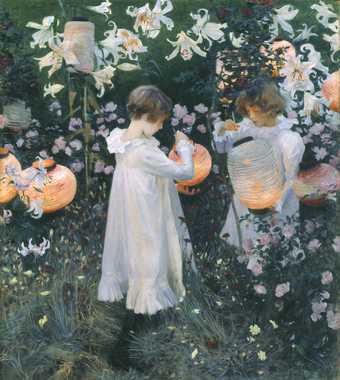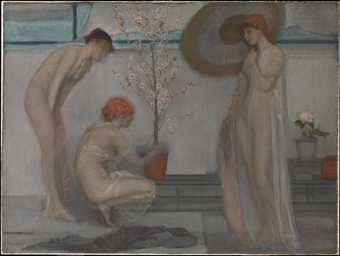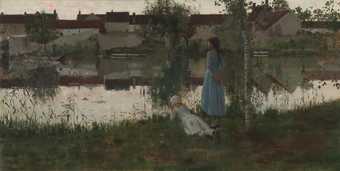
William Stott
Le Passeur (The Ferryman) 1881
Tate
This resource is inspired by, and includes excerpts from, an interview between artist Keira Greene and Tate curator Alison Smith about Le Passeur. The interview also appears in full in a printed publication created by Keira Greene and Tate's Schools and Teachers Programme.
Introduction
Two girls wait patiently by a river for a ferry that has just left the opposite bank. They seem lost in their own thoughts and their reverie is echoed in the brooding stillness of the evening.
Although apparently a depiction of an everyday scene, the painting has a mesmerising, otherworldly magic that has charmed and fascinated viewers since it was first exhibited. In a review written in 1889 for the Scottish Art Review, critic Alice Corkran talks of the ‘spell’ cast by Stott: ‘the secret charm of the picture consists in its witching harmony and restfulness, unbroken by any intrusive emotion brought into it by the human world’.
Nature, rural life and community living
Le Passeur was painted in the late summer of 1881 while William Stott was living among an international community of artists, writers and musicians in Grez-sur-Loing, a village around 70 km south of Paris. Stott was one of many British students who, dissatisfied with the academic system of training at home, had moved to France to develop their artistic practice. The appeal of the French atelier system of art training was that young artists had the opportunity to work with established artists in their studios, getting hands-on experience and advice.

John Lavery (Irish, 1856-1941)
On the Bridge at Grez, 1884
Oil on canvas, 49 x 100.5 cm
Heritage Gift, Lochlann and Brenda Quinn, 2008
NGI.2008.96
At only an hour’s journey time from Paris, Grez became an ideal retreat for artists wanting to escape the city and live in a rural environment. By the time Stott arrived there in 1880 there was already an established international community of artists and writers living and working in Grez. One early resident of the community was Scottish writer Robert Louis Stevenson. He described the village as ‘a pretty and very melancholy place … [lying] … out of the forest, a cluster of houses, with an old bridge, an old castle in ruin, and a quaint old church’.
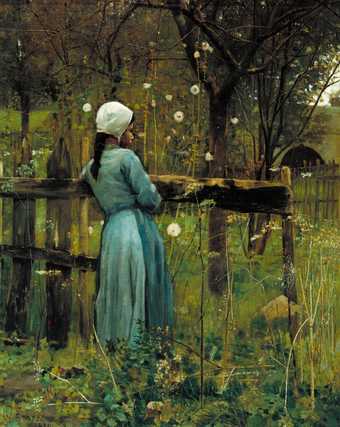
William Stott of Oldham
Prince or Shepherd? (Prince ou Berger?)
(1880)
Tate
The rural location and the creative community at Grez played an important role both in the development of Stott’s technique and the things he chose to paint.
Although the subject of Le Passeur is waiting for a ferry, nature is perhaps the most dominant presence in the work. Critic Alice Corkran described the natural environment in another work Stott painted at Grez, La Baignade, as a ‘deep-pulsing vitality’ casting its ‘sensuous spell … over the spirit on such a day, amid such surroundings’.
Being in a community of other artists inevitably involved a sharing of ideas which led to Stott experimenting with style and technique. As Tate curator Alison Smith suggests:
It was to do with living outdoors and mingling with other artists, exchanging ideas and practices. If you look at the work of Stott alongside other artists, such as John Lavery, John Singer Sargent, Frank O’Meara, and Lowell Birge Harrison, you see that there are certain motifs also techniques in common.
Discussion points
- What if any are the difference in our understandings of a colony and a community?
- Where is the common ground?
- How do we break away?
'Plein air' painting and the break with tradition
Many artists in the second half of the nineteenth century were increasingly keen to break away from the stranglehold that traditional, academic teaching and practice had on landscape painting.
The academic approach dictated that landscapes should be painted in the studio, using a set of pre-defined, established rules to ensure that they conform to an idealised classical composition. Artists such as Stott were interested in developing new ways of painting nature, including painting out of doors (or en plein air). French naturalist painter Jules Bastien Lepage (1848–1884), who painted rustic scenes using plein air methods, was an important influence on Stott and his fellow artists at Grez.
Le Passeur was painted on the banks of the river at Grez and the two girls would have been local villagers, paid to pose for the picture. Although in Stott’s depiction the picture is one of calm and tranquillity, it would probably have been a rather bustling scene with a group artists gathering around to paint the posed girls.
Artist Keira Greene and curator Alison Smith discuss the importance of this new approach to painting landscape scenes – out of doors and on the spot:
Keira Greene: What was the socio-political shift for artists to start working in this plein air manner?
Alison Smith: I think they wanted to show that landscape painting could be as high-minded and elevated as traditional mythological and biblical subjects. Stott's classical training is revealed in the formal elements of his picture, but he also wanted to convey existential themes through nature.
I think a lot of artists were thinking, ‘in the modern age we don’t need to depend on all these classical contexts, we can actually look at the world around us to find meaning’.
KG: And also it seems to be a shift in the representation of nature, I guess, symbolically it is not coming through as a sort of rapturous moment, it’s very stripped back.
AS: I think the artists thought that in ordinary things there is beauty. It doesn't have to be a glorious sunset or sunrise, you could just take an ordinary scene and invest it with grandeur.
KG: And that would have been quite a radical move at that point?
AS: I think so, yes, particularly with British landscape painting. Traditionally artists would have painted the Alps or the Himalayas or somewhere sublime, or you had little picturesque cottages and they had to look interesting and quirky or full of sentiment. But here Stott's just taken an ordinary scene, nothing particularly special, and he's invested it with a sense of meaning and emotion, monumentalising it.
Composition and technique
As well as its plein air technique, the structure of the composition of Le Passeur and Stott's rendering of elements within it, mark it as a departure from more traditional approaches to landscape and reflect contemporary developments in painting.
Stott's broad brush strokes are impressionistic. The precise silhouetting of the dark reeds against the pale expanse of the river suggests the influence of japonisme. His use of colour, muted tonal harmonies and the extraordinary effect of luminosity, are possibly inspired by the work of Scandanavian painters such as Carl Larsson and Karl Nordström, who both spent time at Grez. These elements, along with the rhythmic pattern created by roofs, gables and garden walls, give the surface of the painting a decorative, jewel-like quality.
The simple geometry of the composition is reminiscent of the paintings of Pre-Raphaelite artist Edward Burne-Jones; but also, as Alison Smith suggests, looks forward to twentieth century modernism. ‘It’s very geometric and it almost reminds me of early [Piet] Mondrian painting, you have these vertical and horizontal alignments’.
Symbolism: The river, the ferryman and the passage of time
Although breaking with tradition in relation to subject and approach, the symbolism Stott uses is very much of its time and would have been widely recognised by viewers looking at the work. Rivers are often used in Victorian art and literature as a metaphor for the passage of time, while the motif of the ferryman was an established symbol in classical iconography, alluding to Charon crossing the River Styx and the Acheron to the other world.
Curator Alison Smith reflects on Stott’s use of this symbolism in relation to the two girls in Le Passuer:
It’s quite interesting the relationship between the two girls. The older girl is looking at the ferryman, so there is some recognition of him; whereas the younger girl is just looking at the leaves in the water, so she’s not really aware, she hasn’t reached that state of consciousness yet, that’s perhaps what Stott's implying.
I suppose the river traditionally is the river of life, [the ferryman] is on the other side, but she seems to be aware that he’s coming towards her. So the idea is that she is aware that death exists in the world and one day Charon will take her over to the other side. That’s the implication, and it’s touched upon, it’s not made overt, it seems to be hidden in the painting, so people at that time who had a classical education would have picked up on that association.
Discussion points
- How can we speak through time?
- Is it possible to experience time as non-linear?
Gender, gesture and the female gaze
The two main protagonists in Stott’s painting are female. They have their backs to us, but it is they who determine how we as the viewers look at the painting, directing our gaze across the river and ensuring we notice the ferryman.
Ideologically there has traditionally been the idea that women are closer to nature than men, and through their reproductive function they are tied with the cycles of nature. By depicting the girls in a natural environment Stott seems to be going along with this, but there is also a sense that he is playing with this traditional iconography. The confidence of the pose and gesture of the standing girl perhaps implies that she is not simply bound to nature and tied to its inevitable cycle, but is in control of her destiny. As curator Alison Smith points out, the girl is straight-backed like the tree, suggesting an equation between her and the tree, but at the point where her head is, the tree branches off in a slightly different direction.
The gaze of both girls also suggests a spiritual or psychological aspect to the work. The standing girl looks across the river (which symbolises the passing of time, the future); while the younger girl seems to be looking at her reflection in the water.
The presence and gesture of the girls was almost certainly influenced by the French painter Jules Bastien Lepage. Although Bastien Lepage painted naturalistic scenes, they also often have an element of sentiment or emotion attached to them. As Alison Smith suggests:
Influenced by Bastien Lepage, Stott often focused on young women who seemed to posess some supernatural or spiritual quality or who are caught at some liminal or transitional moment in their existence.
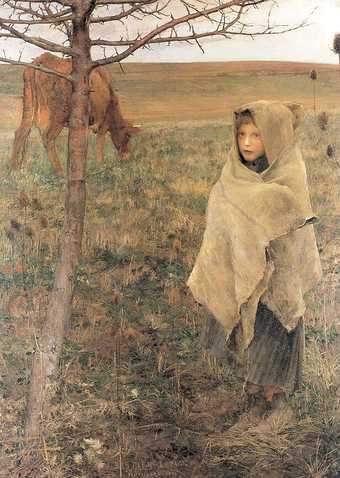
Jules Bastien Lepage
Pauvre Fauvette 1881
What does this suggestion of the psychological – or spiritual – suggest about Stott’s attitude to women? Keira Greene and Alison Smith share their thoughts:
KG: You could read a lot into their gesture and I suppose, now, from a contemporary position and the gaze of and on these women, and it’s interesting to think about where they sit in relation to ideas of innocence. What has been said about Stott’s position on that? Is he romanticising this?
AS: I think this is rather romantic. In Britain he would have been influenced by artists of the aesthetic movement such as Whistler, who was known for his paintings of young women gazing into mirrors as if confronting a doppelganger. They’re expressing something uncanny, or looking at themselves in another state of existence. He may also be thinking of Burne-Jones and his symbolist and spiritualised images of women.You have this mirroring effect … the sky reflected on the water, so the girls can probably see themselves reflected. The implication being they are thinking about themselves …
KG: What might [Stott’s] exposure have been to early ideas around psychoanalysis?
AS: Probably conversations with other artists.
People were talking about expression in art. There were books analysing body language, expression and how to represent feeling in art.
A lot of poetry and literature at the time touches on this –the novels of writers such as George Eliot and Thomas Hardy – and I think Stott would have been well-read. Robert Louis Stevenson of course resided at Grez and was interested in the supernatural.
KG: So was it actually also a shift, you just mentioned Hardy, a shift in empathy towards women?
AS: Yes Hardy’s novels, like Tess of the d’Urbervilles, show huge empathy towards women. It's as if he were trying to see life from their point of view and live their feelings and experiences.
KG: So that might have been something that William Stott was thinking about?
AS: Yes, I think he was someone who got on well with women. His pictures reveal some sort of identification with them. Maybe he thought there was a feminine side to himself that he could explore consciously or unconsciously through his art.
In landscape painting artists often show a figure pointing – usually a man. Here we are invited to follow the gaze of the girl in blue.
Discussion points
- How is art connected with empathy?
- Can a community structure collapse or re draw traditional gender principles?
- How are the ways we can come to embody difference?
- Can we truly understand the gestures of others?
Legacy: reactions, impact and influence
Stott exhibited Le Passeur at the Paris Salon in 1882. The Salon was arguably the most important art event in Europe at that time. Stott was awarded a medal and he was heralded as one of the most talented English painters of his day. French critic Victor Champier observed that connoisseurs were: ‘Surprised, charmed and overcome by the sincerity, absolute originality and the captivating rare delicacy of his works’.
Despite success in France however, Stott’s work was more coolly received in England. Its broad brushwork and naturalistic approach signalled a decisive departure from the detailed rendition and idealised or spectacular landscape scenes found in much British landscape painting of the time.
John Ruskin, the art theorist and critic who had championed the Pre-Raphaelites, criticised Stott and other young British artists who were similarly experimenting with naturalism. He declared that the English School was in peril, ‘our talented young painters succumbed to French Naturalists’.
Le Passeur however proved to be an important artwork in the development of British painting. Its poetic naturalism influenced the work of the anti-establishment Glasgow Boys, as well as inspiring ‘modern realists’ such as George Clausen.
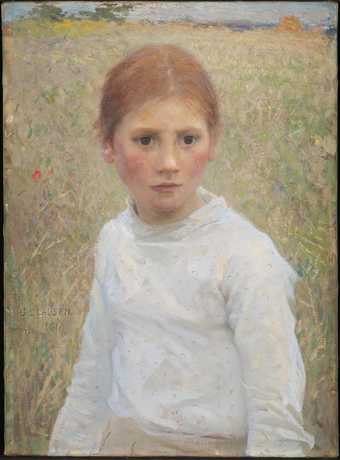
Sir George Clausen
Brown Eyes
(1891)
Tate
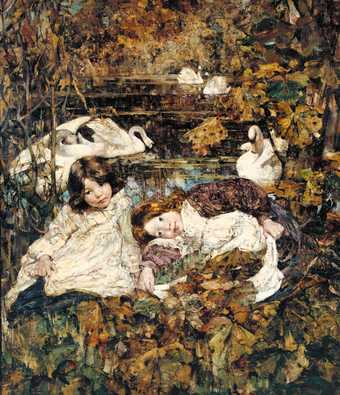
Edward Atkinson Hornel
Autumn
(1904)
Tate
Like Stott, these painters specialised in rustic scenes with symbolist connotations, many of which also present young women in deep in contemplation.
It was also an important painting in the development of British plein air-ism and a pre-cursor to the British impressionist movement.


